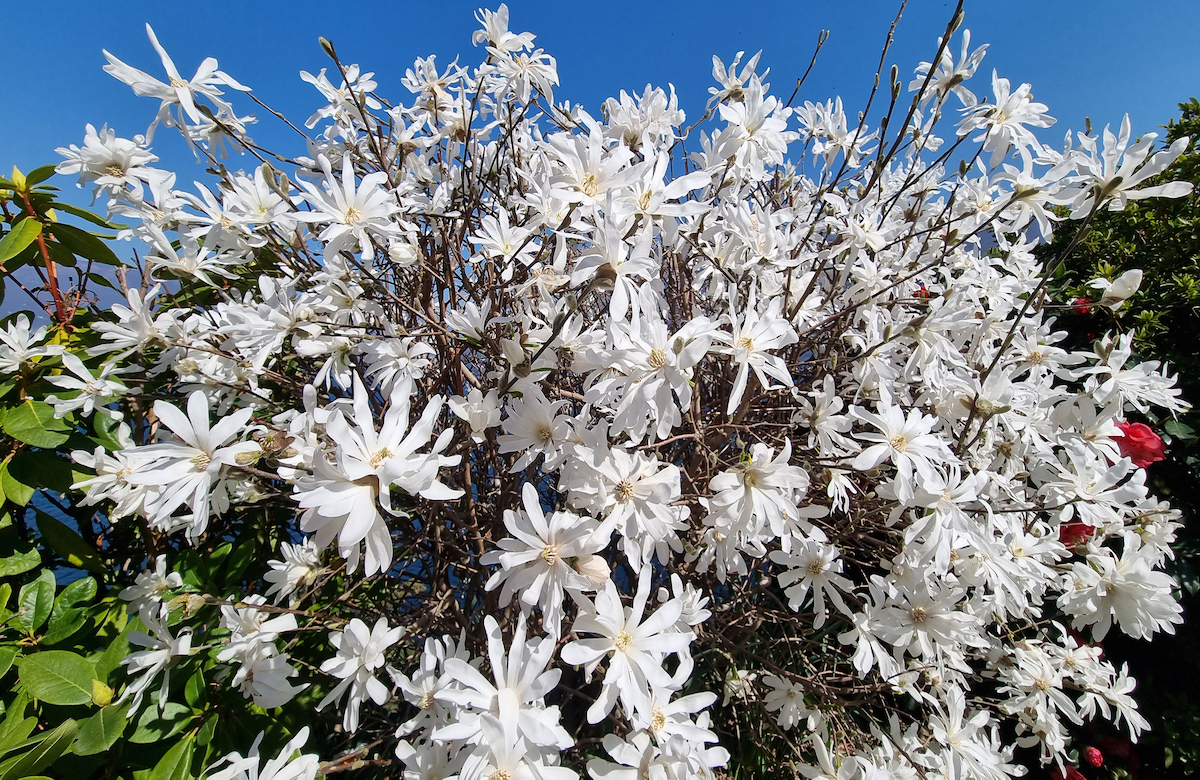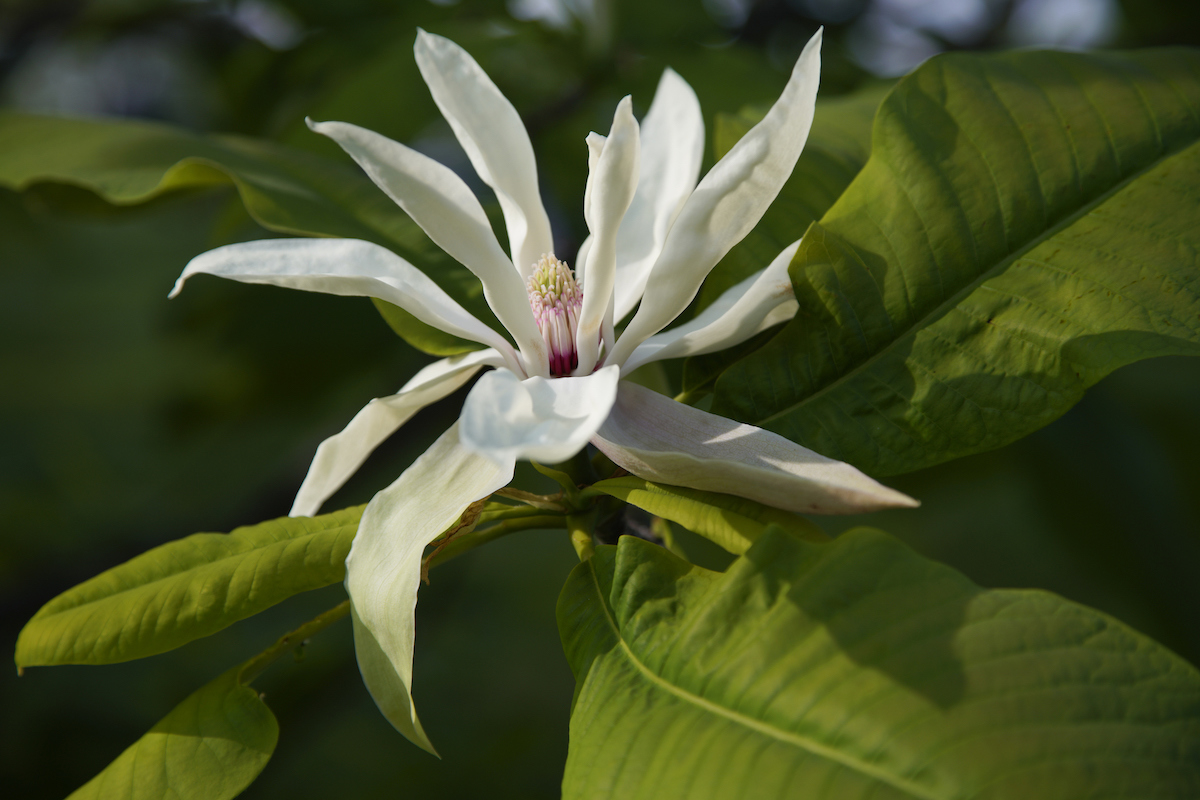

We may earn revenue from the products available on this page and participate in affiliate programs. Learn More ›
Magnolia trees are some of the earliest-blooming flowering trees and shrubs each year. Most produce large, cup-shaped white, pink, or lavender flowers in late winter or spring, with Asian magnolias generally flowering before their glossy foliage appears and North American varieties afterwards. Those magnolia tree blossoms, which have a citrusy aroma, are followed by brown, pink, or red cone-like pods containing red seeds.
Whether you’d like to identify a magnolia or want to pick the perfect tree for your yard out of the hundreds of species out there, we’ve curated a handful of popular magnolias below. Just keep in mind that the types of magnolia trees described here are the original species, meaning their cultivars might have different traits.
1. Sweetbay Magnolia (Magnolia virginiana)

Most common in coastal areas of the US Southeast but found as far north as New York, this native deciduous-to-evergreen magnolia tree (or shrub) grows up to 100 feet tall. Sweetbay magnolia trees begin to produce 2- to 3-inch lemon-scented white flowers in spring, which can continue to bloom on and off during the summer.
Hardy in USDA Zones 5 through 10, the sweetbay magnolia tolerates swampy soils better than most magnolias, but it’s currently an endangered plant in New York and threatened in Pennsylvania. Two cultivars, ‘Emerald Tower’ and ‘Northern Belle,’ can remain evergreen as far north as Zone 4.
Best For: Lawns, shade, and rain gardens
2. Saucer Magnolia (Magnolia x soulangeana)

Also known as the Japanese magnolia plant, this hybrid actually is a cross between the Chinese species M. denudata and M. liliflora. It is named for Etienne Soulange-Bodin, the French cavalryman who created it after Napoleon’s defeat allowed him to ride his passion for horticulture to a more lasting kind of glory.
Growing over 30 feet tall and blooming in late winter to mid spring before its 3 to 6-inch leaves appear, this deciduous type is hardy in USDA Zones 4 though 9. Its 5- to 10-inch white, pink, or lavender blooms, seen in cultivars such as ‘Ann’ and ‘Rustica Rubra,’ can be either cup or saucer shaped.
Best For: Lawns and patios
3. Southern Magnolia (Magnolia grandiflora)

True to its grandiflora species name, the classic southern magnolia tree produces large white blooms 8 to 12 inches across during late spring and early summer, though it may make encore performances later. Growing up to 80 feet tall, this flowering tree sprouts 5- to 10-inch dark evergreen leaves with lighter green or rust hued undersides.
It makes an imposing shade tree for large properties in Zones 6 though 10 but may look a bit overwhelming on smaller ones. If you prefer a more compact version of all that southern splendor, try cultivars such as ‘Bracken’s Brown Beauty’ or ‘Little Gem.’
Best For: Lawns and shade
4. Star Magnolia (Magnolia stellata)

Native to Japan and reportedly the earliest deciduous magnolia to flower, this type generally tops out at 20 feet with 3 to 4-inch white star-shaped flowers in late winter and early spring. According to Jeffrey Gillman, director of the UNC Charlotte Botanical Gardens, “There are an incredible range of showy magnolias, but my favorite is the star magnolia. It puts on a great show and stays a reasonable size for most gardens.”
Hardy in Zones 4 through 8, stellar stellata also will bloom when young. For a pink magnolia tree choose a cultivar such as ‘Pink Stardust’ or ‘Rosea’ instead.
Best For: Foundation planting and patios
5. Cucumber Magnolia (Magnolia acuminata)

A deciduous native tree with golden fall color, cucumber magnolia grows to a height of up to 80 feet with 2- to 4-inch chartreuse, tulip-shaped flowers in late spring or early summer. Often hidden by the 6- to 10-inch leaves, those blooms are followed by cucumber-shaped fruits that mature to red with red seeds.
This magnolia makes an imposing and fast-growing shade tree, perfect for protecting grass, people, and pets from the sun in warmer months. For more prominent yellow flowers, consider cultivars such as ‘Butterflies’ or ‘Elizabeth.’
Best For: Lawns, shade, and native gardens
6. Bigleaf Magnolia (Magnolia macrophylla)

According to North Carolina State Extension, this deciduous bigleaf magnolia has “the largest simple leaves and largest flowers of any tree indigenous to North America.” Matt Lobdell, president of Magnolia Society International, reports that he initially was “taken aback by its huge leaves at least as long as my forearm and proportionally large flowers. The whole tree had a decidedly prehistoric and tropical appearance despite thriving outdoors.”
Growing up to 40 feet tall in Zones 5 to 8 it sports leaves up to 3 feet long and 8 to 14-inch wide white flowers in spring and early summer. Cultivars include ‘Palmberg’ and ‘Purple Spotted.’
Best For: Lawn, shade, and native gardens
7. Lily Magnolia (Magnolia liliiflora)

Gardeners who prefer small magnolia trees or at least smaller magnolia tree leaves should try the relatively Lilliputian lily type, which tops off at 12 feet tall, its 3- to 6-inch purple-backed white flowers appearing in mid to late spring. This Chinese deciduous species with 4- to 8-inch leaves may bloom again during the summer in Zones 5 through 8, making its cultivars ideal small trees for front yards. Try ‘Nigra’ or ‘O’Neill’ for the purplest flowers.
When planting a magnolia tree, avoid a south-facing site, as those warmer locations may cause buds to open too early in the spring—and freeze as a result.
Best For: Containers, patios, and cottage gardens
8. Kobus Magnolia (Magnolia kobus)

Deriving from the Japanese kobushi for “fist” in reference to its opening buds, the kobus magnolia flowers in late winter or the beginning of spring before its 8-inch leaves appear. However, it may require 25 years of growth before it will flower well—especially if grown from seed. It can reach 40 feet in height in Zones 5 to 8 with 3- to 6-inch white flowers and is tolerant of alkaline soil.
Fortunately, this is tree can be propagated from cuttings, as cutting-grown magnolia trees generally mature much faster than those produced from seeds.
Best For: Flowers, hedges, and attracting songbirds
9. Loebner Magnolia (Magnolia x loebneri)

Gardeners who don’t want to wait on Magnolia kobus should try the Loebner flowering magnolia tree which is a cross between M. kobus and M. stellata. Named for Max Loebner, the German horticulturist who created it, this deciduous hybrid with 3- to 6-inch leaves reportedly can bloom when quite young and eventually will reach 30 feet in height with 3- to 6-inch white flowers in late winter or early spring. Its cultivars include the pink and white ‘Leonard Messell’ and the white ‘Spring Snow.’
Best For: Garden accents and winter gardens
10. Umbrella Magnolia (Magnolia tripetala)

A deciduous native tree, this shade-tolerant magnolia grows to 45 feet with 2-foot leaves in umbrella-like whorls. Its 6- to 10-inch white flowers are described as “unpleasantly scented” and appear in mid to late spring in Zones 5 through 8. Its unusual leaf structure gives it a somewhat tropical, palm-like appearance even though it is a relatively hardy plant.
Best For: Native gardens and attracting songbirds
11. Oyama Magnolia (Magnolia sieboldii)

Native to China, the oyama (“small mountain”) magnolia grows to 20 feet, its 4-inch dangling white flowers sporting crimson stamens. Named for German plant collector Philipp Franz von Siebold and blooming from late spring to mid-summer, the deciduous tree or shrub has 3- to 6-inch leaves that turn yellow in fall in Zones 6 to 8.
All those seasons of color make it one of the best trees for the front yard, while its tolerance for shade may make it an ideal backyard tree, as well. Try ‘White Flounces’ for semi-double blooms, or ‘Michiko Renge’ for double blooms.
Best For: Courtyards, shade, and woodland gardens
12. Wilson’s Magnolia (Magnolia wilsonii)

Similar to M. oyama and named for E. H. Wilson, the English plant collector who visited China and first gathered the plant’s seeds for export, the Wilson species also grows to a height of up to 20 feet in Zones 6 through 9. Its 3- to 5-inch dangling white flowers, which appear in late spring and early summer, also feature red or magenta stamens.
It is considered a threatened species and tolerates alkaline soil. Although magnolias can grown as be full-sun shrubs, they generally do best in partial shade in southern climates.
Best For: Courtyards, shade, and woodland gardens
13. Chinese Evergreen Magnolia (Magnolia delavayi)

Named for French missionary Jean Delavay, who originally collected its seed for export, this evergreen magnolia can grow up to 40 feet tall and produces 6 to 8-inch white or pink blooms in mid-to-late summer rather than spring. Because the showy, night-fragrant flowers don’t last long, the plant often is grown for its 4- to 12-inch leathery leaves rather than its blooms and is hardy only in Zones 8 or 9 through 11.
Best For: Night garden, wall shrub, woodland garden
14. Japanese Bigleaf Magnolia (Magnolia obovata)

Japan has its own big-leafed magnolia. The Japanese bigleaf magnolia’s species name, obovata, means “egg-shaped” in reference to its oval green leaves, while its alternative species name, hypoleuca, means “white below,” in reference to those leaves’ lighter undersides. The tree grows to a height of about 40 feet with 6- to 20-inch leaves. Its 8-inch white flowers (decorated with red stamens) appear in late spring and early summer in Zones 6 through 9.
Best For: Courtyards, shade, and woodland gardens
15. Banana Magnolia (Magnolia figo)

Gardeners who would like a spring bloomer that looks and smells different than any other in the neighborhood should try growing one of the most unusual magnolia varieties—the banana type. Native to China, the banana magnolia grows up to 20 feet tall and blooms in late spring with 1- to 4-inch cream-to-yellow flowers, which smell like bananas! Often tinged with purple, green, or yellow, those blooms appear against a background of 3- to 6-inch leaves in Zones 7 through 10.
Best For: Foundation shrubs, hedges, and Asian gardens
